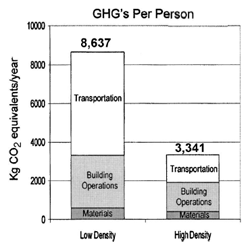
So we think there are plenty of good reasons for policymakers to be favorably disposed to fostering more housing close to downtown. But the following chart illustrates another key reason: Living in a dense neighborhood has less impact on the climate.

There’s an interesting side note to this study (well, interesting to me, anyway). Looking only at buildings alone—that is, leaving out transportation—it looks as if greenhouse emissions per square foot of living space are a teensy bit higher in dense urban areas than in sprawling neighborhoods. I would have expected the opposite, since living in a high rise means you share walls with your neighbors, and thus leak less heat to the outside world. But this study suggests otherwise—measured per square foot, the author found that energy consumption was pretty comparable in urban vs. suburban homes.
However, measured per person rather than per square foot, city dwellers do far better than single family homes—mostly because people end up living in smaller spaces in the city. And regardless, the overwhelming GHG difference between city and suburban living is in transportation. That’s where the GHG benefits of city living really kick in.
* Study citation: Jonathan Norman; Heather L. MacLean, M.ASCE2; and Christopher A. Kennedy, “Comparing High and Low Residential Density: Life-Cycle Analysis of Energy Use and Greenhouse Gas Emissions“, Journal of Urban Planning and Development, March 2006, pp. 10-21.
Photo of street scene courtesy of Gordon Price


